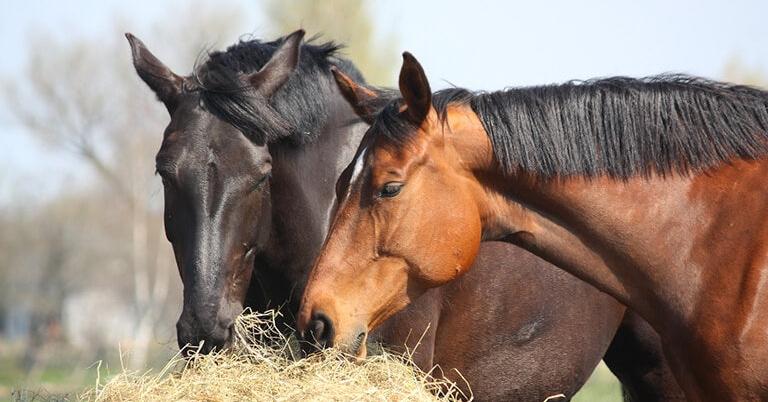While hay is a great source of calories and nutrients for horses, it can lack certain vitamins and minerals. This can be remedied by providing a white salt block or loose salt in the feed ration.
Hay is cut and dried grasses or legumes such as alfalfa and clover that are in an immature state so they can be easily digested.
Why Do Horses Need Hay?
Horses are herd animals by nature and thrive when allowed to graze all year round. However, with limited pasture available in the winter months, many pleasure horse owners choose to keep their horses stabled and give them constant access to horse hay and other conserved forages. Hay provides the bulk of a horse’s diet, providing essential fiber to maintain digestive health.
Hay is also an important source of energy. It helps support core body temperature, especially when fed to a horse with a full coat. In addition, high-quality timothy or alfalfa hay can be an excellent source of protein and calcium. These types of hay are ideal for young and growing horses, pregnant or lactating mares, and performance and working horses.
Forage should make up the majority of a horse’s diet, but when it is not possible for a horse to have constant access to fresh pasture, good-quality hay should be the primary feed source. Horses can derive most of their calories and protein needs from a hay-based diet and most of their macro minerals (calcium, phosphorous, magnesium, potassium). However, a hay-based diet is usually low in trace nutrients such as copper, zinc, and selenium. For this reason, a mixed “complete” feed is often recommended as a supplement to a horse’s hay-based diet.
Besides ensuring that a horse has adequate nutritional balance, feeding quality hay is vital to prevent digestive upset and respiratory issues. Poor-quality hay can be loaded with dust, which can irritate a horse’s respiratory and digestive tract. In addition, mold and other contaminants can also be harmful to a horse’s system.
Good-quality hay is also a more consistent feed than grass or other natural forage. This is important for a horse’s digestive system as it helps to stabilize the pH and consistency of his diet. Furthermore, a horse’s four-chambered stomach is better able to tolerate changes in diet and molds than the digestive tract of other ruminants like cattle.
The quality of hay can vary depending on the season and weather conditions that are conducive to its growth. If the growing conditions are favorable, a plentiful supply may be available at a reasonable price; however, droughts and floods can lead to lower-quality hay or even a shortage of hay in some areas.
How Do I Give My Horse Constant Access to Hay?
A hay bale is a feed source for ruminants that comes from a variety of forage crops. It’s not to be confused with straw, which is not as nutritious and is often used for bedding instead of feeding. You can buy hay in small bales or large round bales, both of which are easy to transport and store. The most important thing is that the hay you choose is high quality and meets your horse’s nutritional needs. It should also be free of mold and dust. It is recommended that you have your hay analyzed to get an idea of what is in it and whether it is healthy for your horse.
The type of hay you choose depends on your horses’ specific needs and the availability of a good supply in your area. Most horses do well on clean grass hays such as timothy or ryegrass. Legume hays like alfalfa and some clovers are also popular as they can be very nutritious for the horse. Some horse owners use a mix of forage and grain in the form of a “complete” feed to help them meet their horses’ nutritional needs.
In addition to making sure your hay is fresh, it’s important to keep in mind that the way you store and handle hay can impact its quality. If hay is stored properly and protected from rain, it can last longer and maintain its nutritional value.
It’s best to put hay in a breathable, ventilated barn that isn’t overly cold or warm. This will help reduce moisture and mold. Also, avoid storing hay in damp places or direct sunlight, which can cause spoiling.
If you have to store hay outdoors, make sure it’s kept covered or in a shed to protect it from the elements. Hay that is exposed to the sun can deteriorate more quickly and may have a musty or unpleasant smell.
It’s important to check on hay often so that you know when it is time to replace it. Hay should be a bright green color and have a fresh, pleasant aroma. It should also be free of dirt, dust, and bugs. Also, be sure that the hay you are buying has a high digestible energy content for your horse.
What if I Can’t Give My Horse Constant Access to Hay?
While giving your horse constant access to hay is ideal, it’s not a requirement. It all depends on your horse’s dietary needs, which vary by individual. As a general rule, horses need to eat 2% of their body weight in forage daily. This is especially important during the winter months when it’s harder for horses to eat enough grass to meet their caloric requirements.
Horses evolved in environments where they grazed constantly and frequently, so their digestive systems are designed for this. It’s also how they get the most out of their forage, as consuming small amounts more often allows them to make better use of the nutrients in it. When horses don’t have continuous access to forage, their digestion may suffer, which can lead to gastric ulcers.
To help prevent this, feeding horses three or four times a day rather than just once or twice is recommended. It helps keep their stomachs and hindguts occupied so they don’t stress and work too hard to digest food. Plus, a more frequent feeding pattern can help prevent overfeeding, which is another common cause of digestive issues in horses.
For those who are unable to offer their horses constant access to hay, a good alternative is a high-quality hay mix. This can be soaked to lower its moisture content, which helps prevent digestive problems and contains other nutrients and vitamins that are not found in pasture grass. It’s also a great way to give horses something to chew, as they will still need forage in their diets to maintain healthy teeth and digestive tracts.
There are many different types of hay, but they can be broadly classified into grass hay and legume hay. Grass hay is typically a mixture of cool and warm seasonal grasses, which differ in nutrient content, cost, and regional availability. Leguminous hay is generally made from alfalfa but can also contain peanuts, peas, soybeans, and other legumes.
When choosing hay, it’s important to select a quality product that’s high in fiber and low in sugar, which is particularly beneficial for horses with diabetes or other metabolic conditions. It’s also a good idea to store hay in a cool and dry place, as this will help keep it fresher for longer.
What Can I Do to Give My Horse Constant Access to Hay?
Horses that are given constant access to hay can be fed a little less supplemental grain. This can be especially helpful in winter or drought when pasture grazing is limited or non-existent. This is important as horses that have to eat a small amount of grain and a large amount of hay can put on too much weight, leading to health issues down the line.
It is also important to ensure that the hay you are giving your horses is high quality. Poor-quality hay can be low in nutrients, and moldy hay can be dangerous to horses’ respiratory systems. You can test the quality of your hay by soaking some in water for 2 hours. If the hay does not come up clean, this is a good indication that it needs to be replaced.
If you are going to be feeding your horses hay all the time, consider purchasing a few months’ worth at a time. This will ensure that you always have enough hay on hand and that the hay you have is of a consistent quality. It will also help your horses get used to the idea of consuming smaller amounts of hay throughout the day rather than in one or two large meals.
Another thing to consider is using a hay net or rack to slow down your horse’s grazing. These are available from most tack stores and can be easily added to your stables or paddocks. They work similarly to trickle feeders and can be an excellent way to reduce your horses’ eating speed.
A final thing to keep in mind is that hay is not the complete solution to your horse’s dietary needs. It is high in fiber, which is essential for the digestive system, but hay does not contain all of the vitamins and minerals that horses require to live a healthy life. In addition, hay is usually low in moisture, which is why horses should be provided with plenty of water along with their hay.
If you are able to provide your horses with good-quality hay and let them graze in their paddocks most of the time, they might not need any supplemental grain at all! This will allow them to practice their natural foraging behavior and help their digestive systems function properly.







